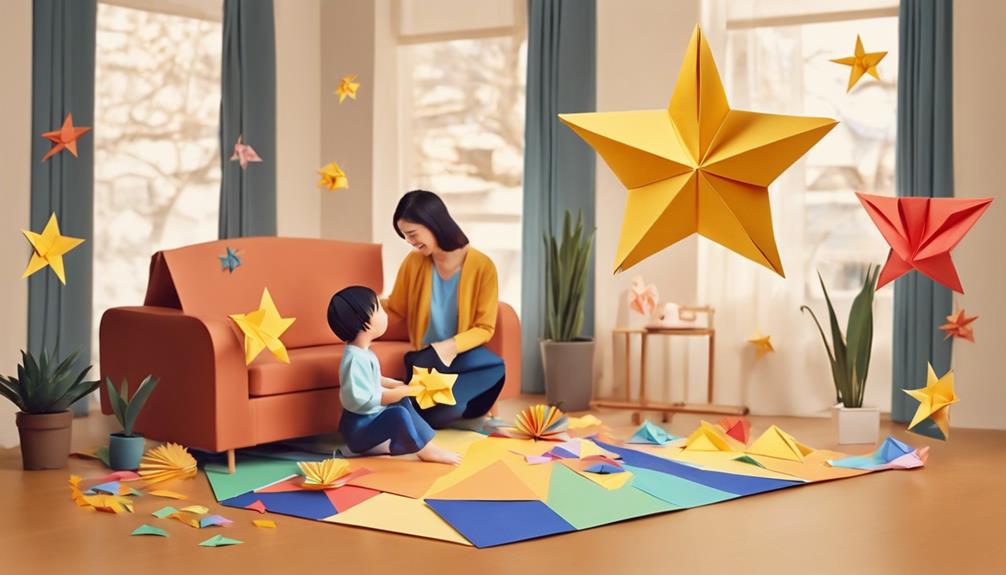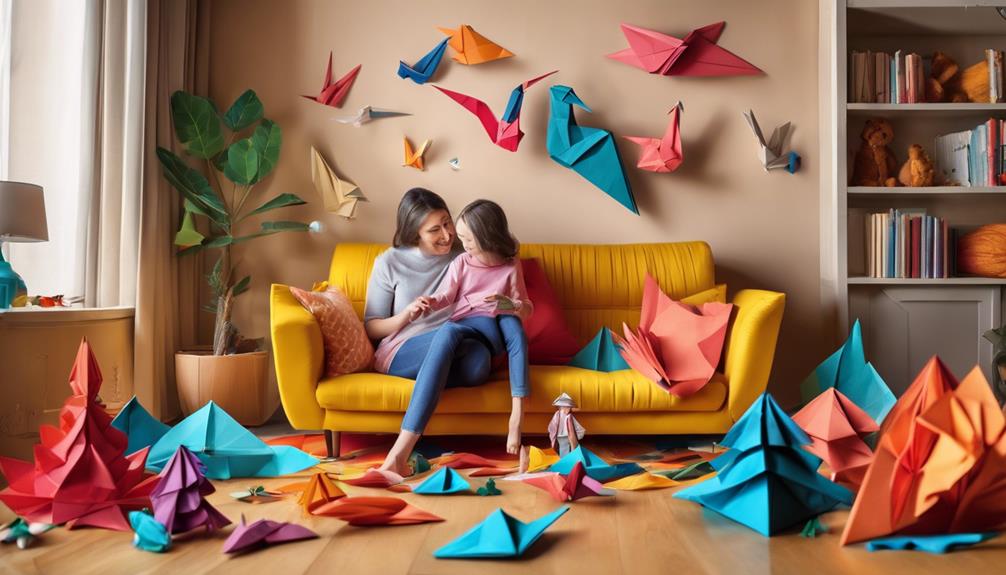Mastering the art of talking with your child means understanding their unique preferences and emotions. Pay attention to their body language and reactions; it provides valuable insights. Engaging in active listening, maintaining eye contact, and using reflective listening can build trust and empathy. Encourage open-ended questions to spark deeper conversations and enhance critical thinking. Positive reinforcement, like verbal praise, boosts their confidence. Incorporate storytelling and role-playing to develop emotional intelligence and communication skills. Always model good communication by being genuine and respectful. Progressing through these steps fosters a strong bond and creates an environment where meaningful exchanges flourish. Discover the subtleties of these techniques next.
Key Takeaways
- Observe your child's unique preferences and reactions to tailor conversations effectively.
- Use active listening techniques, like maintaining eye contact and reflective listening, to show engagement and empathy.
- Ask open-ended questions to encourage deeper conversations and enhance cognitive development.
- Employ positive reinforcement to reward and promote desired behaviors, boosting self-esteem and motivation.
- Integrate storytelling and role-playing to make conversations engaging and foster emotional intelligence.
Understanding Your Child's Needs
To truly understand your child's needs, you'll need to pay close attention to their unique preferences, emotions, and developmental stages. Children are individuals, each with their own way of expressing themselves and understanding the world. By observing their behavior, you can gain insights into what makes them tick and what they might be struggling with.
Noticing how they react in different situations, what activities they enjoy, and how they interact with others can tell you a lot about their needs. Pay attention to their body language and facial expressions—these nonverbal cues often speak louder than words.
When your child feels heard and understood, it builds a strong parent-child bond, fostering a sense of security and trust. Tailor your communication to fit their developmental stage. Younger children might need simpler explanations and more patience, while older kids might appreciate more detailed discussions.
Understanding your child's unique needs isn't just about solving problems; it's about nurturing their overall well-being and helping them grow into confident individuals. By being attuned to their needs, you'll be better equipped to support their emotional and developmental journey, ensuring they feel valued and loved.
Active Listening Techniques

To practice active listening with your child, start by maintaining eye contact to show you're fully engaged and present.
Use reflective listening skills by repeating or paraphrasing what they've said, which helps them feel heard and understood.
Maintain Eye Contact
Maintaining eye contact with your child during conversations shows you're fully attentive and genuinely care about what they're saying. This simple yet powerful act can greatly help in building a stronger connection with your child.
Talking to your child while maintaining eye contact not only makes them feel heard but also valued. Research indicates that eye contact enhances communication and understanding, making it easier for you to grasp their thoughts and feelings.
Here are three ways maintaining eye contact can improve your conversations with your child:
- Promotes Trust: When you look into your child's eyes while they speak, it fosters a sense of trust and security, encouraging them to open up more freely.
- Gauges Reactions: By maintaining eye contact, you can better gauge your child's reactions and emotions, allowing you to respond more effectively and empathetically.
- Builds Stronger Relationships: Consistent eye contact during conversations helps build stronger, more trusting relationships over time, making your child feel more connected to you.
Reflective Listening Skills
Reflective listening, a key component of active listening techniques, involves paraphrasing and summarizing your child's words to demonstrate understanding and empathy. When you engage in conversations with your child, reflective listening shows them that you're truly paying attention and value what they've to say. By restating their thoughts and feelings, you help them feel heard and respected.
Incorporating active listening techniques, like maintaining eye contact and nodding, further enhances your reflective listening skills. These gestures signal that you're fully present and engaged in the conversation. Reflective listening doesn't just strengthen the parent-child relationship; it builds trust and opens the door to more meaningful exchanges.
When you reflect on your child's feelings and thoughts, you show them that their emotions matter. This practice can improve their communication and problem-solving skills over time.
For instance, if your child says, 'I'm upset because my friend ignored me,' you might respond, 'It sounds like you're feeling hurt because your friend didn't pay attention to you.' This not only validates their emotions but also encourages them to express themselves more openly.
Encouraging Open-Ended Questions
Encouraging your child to ask open-ended questions is a powerful way to foster curious conversations and promote thoughtful responses.
By asking questions that require more than a yes or no answer, you help them explore their thoughts and feelings, nurturing critical thinking and creativity.
This approach not only leads to deeper, more meaningful interactions but also helps them develop essential communication and social skills.
Foster Curious Conversations
Asking open-ended questions like 'What do you think about that?' encourages deeper conversations and helps children explore their thoughts and ideas. This type of rich talk not only expands their communication skills but also nurtures their curiosity and critical thinking. When you ask questions that can't be answered with a simple 'yes' or 'no,' you invite your child to delve into their own mind and share their unique perspectives.
Here are three key benefits of fostering curious conversations:
- Enhanced Cognitive Development: Open-ended questions challenge children to think critically and creatively, boosting their cognitive growth.
- Improved Language Skills: Engaging in deeper discussions helps children articulate their thoughts more clearly, enhancing their overall language abilities.
- Stronger Connections: These conversations build a sense of trust and understanding, strengthening your relationship with your child.
Encouraging your child to express themselves through thoughtful dialogue not only aids in their development but also builds their confidence. By regularly incorporating open-ended questions into your conversations, you create a safe space for them to explore their ideas, feelings, and imaginations. This approach fosters an environment where rich talk becomes the norm, empowering your child to become a more effective communicator.
Promote Thoughtful Responses
Frequently, engaging your child with open-ended questions leads to more thoughtful and in-depth responses. These types of questions encourage children to think critically and articulate their thoughts effectively. Instead of asking yes-or-no questions, try asking, 'What was the most interesting part of your day?' or 'How would you solve this problem?' This approach promotes deeper conversations with kids and allows for more meaningful interactions.
By incorporating open-ended questions into your conversations, you stimulate your child's creativity and problem-solving skills. They've the freedom to express themselves without feeling constrained by narrow answers. For example, when discussing a book they're reading, ask, 'What do you think will happen next?' This not only helps them develop their communication skills but also fosters a sense of autonomy and independence.
Open-ended questions are a powerful tool in nurturing your child's ability to express their opinions and ideas. They learn to articulate their thoughts more clearly and confidently, making your conversations with kids more engaging and insightful.
Using Positive Reinforcement

When you use positive reinforcement, you're actively shaping your child's behavior by rewarding actions you want to see more often. This approach, an important part of the Art of Talking, emphasizes the power of recognizing and encouraging positive behaviors. Instead of focusing on what your child does wrong, you highlight and reward what they do right, fostering a constructive and nurturing environment.
Positive reinforcement can be incredibly effective in promoting self-esteem, motivation, and overall well-being.
Here's how you can implement it:
- Verbal Praise: Simple words of encouragement like 'Great job!' or 'I'm proud of you!' can go a long way in reinforcing good behavior.
- Tangible Rewards: Small rewards such as stickers, extra playtime, or a favorite treat can provide immediate and tangible recognition of their efforts.
- Consistency: Regularly acknowledging good behavior helps children internalize these actions, making them more likely to repeat them.
Storytelling as a Tool

Storytelling is a wonderful way to engage your child in meaningful conversations. It stimulates their imagination, creativity, and critical thinking. When you engage in storytelling, you help kids develop language skills, emotional intelligence, and empathy. This practice fosters a strong bond, promoting trust and communication between you and your child. Your child can explore different perspectives, emotions, and experiences in a safe and imaginative way.
Consider using storytelling to delve into various scenarios and characters. Here's a simple table to guide your storytelling sessions:
| Scenario | Characters | Emotions Explored |
|---|---|---|
| A lost puppy | Brave kid, helpful adult | Fear, courage, relief |
| A magical forest | Adventurous friends | Wonder, excitement, joy |
| A school mystery | Curious student, teacher | Curiosity, surprise, satisfaction |
These stories can help kids see the world from different angles, understanding complex feelings and situations. You can weave in lessons subtly, allowing them to learn without feeling lectured. With each story, you provide a platform for open dialogue, making it easier for them to express their thoughts and feelings.
Managing Difficult Conversations

When tackling tough conversations with your child, staying calm and patient is key.
Always listen actively, showing that you value their feelings and thoughts.
This approach helps create a trusting environment where they feel safe to express themselves.
Stay Calm and Patient
Staying calm and patient during difficult conversations with your child is essential for fostering open communication and mutual understanding. Parents and educators often face challenging discussions, but handling these moments with composure can make a significant difference. By staying calm, you model effective conflict resolution skills for your child, showing them how to manage their own emotions.
Here are some strategies to help you maintain your cool:
- Use Positive Language: Avoid raising your voice. Instead, speak in a calm, even tone. This sets a positive example and helps de-escalate the situation.
- Take Breaks When Necessary: If emotions run high, take a moment to breathe or step away. This gives both you and your child time to cool down and gather your thoughts.
- Acknowledge Feelings: Validate your child's emotions by acknowledging their feelings. This builds trust and strengthens your relationship, making it easier for them to open up.
Listen Actively Always
Active listening is essential for understanding your child's perspective during difficult conversations. To support children effectively, you need to focus entirely on what they're saying. Maintain eye contact, show empathy, and create a safe environment where they feel comfortable expressing their emotions and thoughts.
When your child shares their feelings, acknowledge and validate them. Avoid dismissing or minimizing their concerns, as doing so could make them feel unheard and misunderstood. Instead, practice reflective listening by paraphrasing their words. This guarantees you're accurately grasping their viewpoint and shows that you're genuinely engaged.
Encouraging open communication is vital. Ask open-ended questions that invite your child to elaborate on their feelings and experiences. For example, instead of asking, 'Did you have a bad day?', try asking, 'What made your day challenging?' This approach helps them feel supported and understood.
Providing support means more than just listening. Offer guidance and reassurance, helping your child navigate through tough conversations with confidence. Let them know you're there for them, no matter what.
Building Emotional Vocabulary

Helping your child build an emotional vocabulary empowers them to express their feelings clearly and effectively. As a speech pathologist might tell you, giving your child the tools to articulate their emotions is essential for their overall development. Research shows that children with a rich emotional vocabulary are better at regulating their emotions and forming positive relationships, which is vital for their growth and well-being.
Here are three practical steps to help your child develop their emotional vocabulary:
- Label Emotions: When your child experiences different feelings, help them put a name to it. If they're upset, say, 'I see you're feeling angry.' This helps them understand and communicate their emotions better.
- Use Stories and Books: Reading stories that explore various emotions can be a fun and effective way to introduce these concepts. Discuss the characters' feelings and ask your child how they might feel in similar situations.
- Model Emotional Expression: Show your child how to express emotions by doing it yourself. When you're happy, sad, or frustrated, say it out loud. This sets a powerful example for them to follow.
Encouraging your child to label their emotions can significantly improve their self-awareness, empathy, and conflict resolution skills, setting them up for a healthier emotional life.
Role-Playing Scenarios

Building on your child's emotional vocabulary, role-playing scenarios provide a dynamic way for them to practice these new skills in real-life situations. By engaging in role-playing, your child can explore different perspectives, understand the impact of their words and actions, and develop empathy. This interactive technique allows them to experiment with handling conflicts, regulating emotions, and making better decisions in a safe environment.
Role-playing isn't just about acting; it's about developing social skills and problem-solving abilities. When your child pretends to be someone else, they're not just having fun—they're also learning to navigate the complexities of human interactions. This practice can greatly enhance their confidence and communication skills, making them more adept at expressing themselves and understanding others.
Encouraging role-playing at home can also promote active listening, creativity, and critical thinking. You might find that your child becomes more thoughtful and considerate as they better grasp the nuances of social dynamics.
Whether they're pretending to resolve a disagreement with a friend or practicing how to ask for help, role-playing scenarios can enrich their social and emotional development, preparing them to handle real-life challenges with greater ease and empathy.
Integrating Play Into Conversations

Using play in conversations with your child can make discussions more engaging and effective. Play isn't just about having fun; it's a powerful tool for fostering creativity and comfort.
When you incorporate play-based conversations, your child feels more at ease and is likely to open up more readily. This playful approach can deepen your connection and lead to a better understanding of each other.
Here are three ways to integrate play into your conversations:
- Role-playing games: Create scenarios where your child can act out different roles. This helps them explore new ideas and express their thoughts in a fun, non-threatening manner.
- Storytelling: Encourage your child to tell a story, adding their own twists and turns. This not only sparks creativity but also allows them to communicate their feelings and experiences indirectly.
- Problem-solving challenges: Set up small challenges or puzzles that you can solve together. This promotes teamwork and gives your child a chance to practice important social skills while discussing solutions.
Setting a Good Example

To effectively foster open communication with your child, it's important to set a good example by demonstrating positive communication behaviors. Kids learn a lot by watching how you interact with others, so when you actively listen and engage in respectful dialogue, you're showing them how conversations help build strong relationships.
Active listening means truly paying attention when your child speaks, making eye contact, and responding thoughtfully. This shows them that their words matter and encourages them to open up more. By consistently practicing these habits, you create a supportive environment where your child feels safe to express themselves.
Research indicates that children often mimic the communication patterns they observe in adults. So, when you model good communication, you're not just teaching them how to talk; you're helping them develop essential skills like emotional intelligence and social competence. These skills are critical for their interactions both now and in the future.
Role modeling open and honest communication also fosters trust. When your child sees you being genuine and transparent, they're more likely to reciprocate, strengthening your relationship.
Setting a good example isn't just about talking—it's about being the kind of communicator you'd want your child to become.
Frequently Asked Questions
How to Teach Your Child the Art of Conversation?
To teach your child the art of conversation, encourage them to ask open-ended questions, which promote deeper discussions.
Model active listening by maintaining eye contact and showing genuine interest in their words.
Teach them to take turns speaking and not interrupt others, fostering respect.
Provide opportunities for them to practice with friends and family.
Discuss the importance of body language, tone, and facial expressions in effective communication.
What Is the Art of Conversation for Children?
As the saying goes, 'It takes a village to raise a child.'
The art of conversation for children involves engaging them in meaningful dialogue that nurtures kindness, creativity, and confidence.
When you talk with your child, use back-and-forth communication to spark their imagination and encourage critical thinking.
This approach helps them develop essential social skills, enhances their creativity, and builds their confidence, leading to richer interactions and positive growth.
How to Talk to Your Child so They Will Listen?
To talk to your child so they'll listen, start by using positive language and a calm tone. Show you value their thoughts by practicing active listening, nodding, and responding appropriately.
Set aside dedicated time for meaningful conversations, building trust and connection. Ask open-ended questions to encourage deeper thinking, and always show empathy towards their perspective. This fosters an environment where they feel heard and understood.
How Do I Get My Child to Talk Properly?
Think of teaching your child to talk properly like planting a garden. You don't just throw seeds and hope for the best. You nurture them with open-ended questions and active listening.
Create a safe space where they feel valued, model good communication, and provide storytelling or role-playing opportunities.
Just like plants need sunlight and water, your child's communication skills thrive with your support and patience.
Conclusion
You've got the tools to connect deeply with your child. Imagine a shy 10-year-old, finally opening up because you asked, “What made you smile today?”
Your active listening, positive reinforcement, and engaging questions can create a safe space for honest conversations. Remember, your empathy and patience lay the foundation for your child's emotional growth.
Keep practicing, and watch your bond strengthen, one heartfelt talk at a time. You're doing great—keep it up!
Amina brings over a decade of journalism experience to her role as Editor-in-Chief. Under her leadership, Exquisite Post has flourished, maintaining the highest standards of integrity and excellence. Amina’s commitment to truth and her visionary approach guide the editorial team in producing impactful news stories that resonate with our audience.










